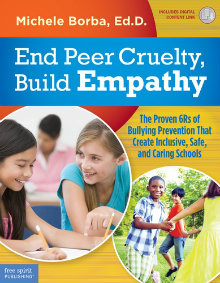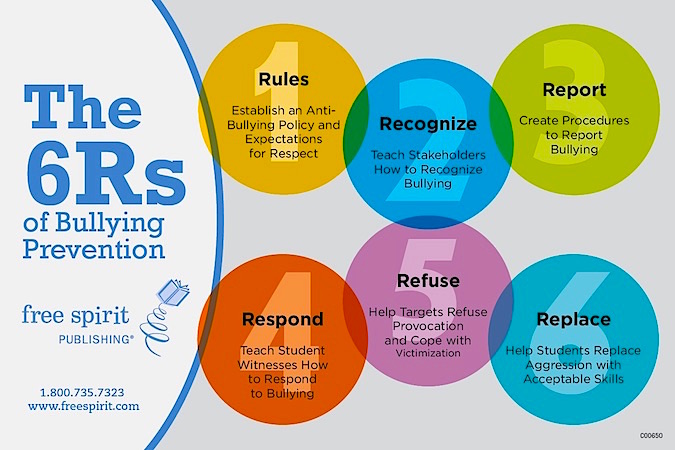Dr. Borba’s Blueprint for Bullying Prevention
 By Michele Borba, Ed.D.
By Michele Borba, Ed.D.
The best way to reduce bullying is not with a one-time assembly or a poster campaign, but with homegrown, data-driven, sustained efforts by a caring and committed staff – a model I call The Six Rs. It’s a blueprint for effective bullying prevention. I’ve shared this model with hundreds of educators and schools worldwide, and on U.S. Army bases.
Each “R” is crucial in creating what our students deserve – a safe and compassionate learning environment that breeds acceptance and respect. But solutions are not simple or quick.
We reduce bullying through the efforts of a committed, informed school community that has been trained in effective anti-bullying techniques. The approaches that are most promising tackle bullying dynamics from many angles and involve all stakeholders.
But the foundation is always based on building a culture of respect and changing destructive attitudes and behaviors by replacing them with healthier habits and views. Here are six evidence-based bullying prevention elements from my book, End Peer Cruelty, Build Empathy, that will reduce cruelty if the staff works together.
1. RULES – Establish an Anti-Bullying Policy
Develop an anti-bullying policy that fits your school values, focuses on prevention, features strong parental involvement, builds a respectful climate, and gets everyone on board. An anti-bullying policy alone won’t stop bullying, but it can be the first step toward mobilizing stakeholders to realize that together you can make a difference.
- Create an action team representing all stakeholders to identify strong anti-bullying practices and procedures, and then develop a policy that fits your culture and students’ needs.
- Delegate tasks such as staff trainer, student coordinator, book club leader and parent educator to boost staff participation.
- Charge staff study teams to start book discussion groups, visit schools with effective programs and attend workshops. Clarify the school’s desired outcomes.
- At a community event, introduce your bullying policy and expectations for respect. Record it on video to show absent staff, students and parents.
- Establish tiered consequences for bullying, which consider students’ ages, maturity, intent and frequency. Emphasize positive discipline approaches – not zero tolerance.
- With student help, identify bullying hot spots. Assign adults to monitor locations vigilantly. Custodians can watch stairwells, coaches can monitor locker rooms, and teachers can check bathrooms. One principal put a cutout of herself in a hallway, labeled: “I’m watching you!” She curbed bullying and made students feel safer.
- Evaluate progress and adjust accordingly.
Staff Chat: Watch a film about bullying as a staff (like Bully or Mean Girls) and then have a serious chat about the need for school-wide bullying prevention and how your own schools’ current policy (or lack of) is working.
2. RECOGNIZE – Teach How to Identify Bullying
All stakeholders must understand what bullying is, recognize indicators, and receive ongoing training so that they can intervene appropriately and consistently. Effective bullying prevention teaches educators, parents, students and community how to identify bullying.
When everyone uses the same bullying definition, responds to student aggression consistently, and demonstrates a serious tone, your school will be far more successful in stopping aggressive behaviors and replacing them with respect and caring.
- Teach four bullying elements: a pattern of repeated, intentional, unjust, cruel behavior that differs from normal peer behavior. Discover where there is a power imbalance. The person bullying has more power due to strength, status, ability, age, or size than the target.
- Develop one PowerPoint presentation so that all teachers teach the same bullying lesson. Send a flash-drive of the presentation home with students to share and discuss with parents as homework.
- Educate parents via coffees, speakers, book clubs, email blasts and newsletters.
- Students can create videos, screensavers, PSA announcements, and posters about bullying for sharing and display throughout your school, buses and community.
- Ask local libraries to display books about bullying, and teachers to integrate bullying lessons using media clips, novels, and discussions.
- Review types of bullying (emotional, verbal, physical, digital) and your policy at a school assembly.
Staff Chat: What are you doing to educate your parents about bullying? Which parents are you reaching or missing? What can you do to reach more parents?
3. REPORT – Create Procedures to Report Bullying
Gather reports from stakeholders to create evidence of bullying frequency and locations. Include names of bullies and victims and boost student security. There is no room in a caring school for the attitude that “Bullying is a phase” or “We can’t do anything about it.” Bullying has to be taken seriously and it can be reduced.
- Create forms for staff, students and parents to report incidents.
- Break the “No Snitch” code. Teach the difference between snitching (getting peers in trouble when they’re not doing anything harmful) and reporting (keeping peers out of trouble because they may get hurt). Encourage reporting.
- Introduce reporting options like a 24-hour phone hot line, a website partnered with police, and report boxes (locked boxes placed in key locations including on school buses). Administrators should review reports daily and follow up.
Staff Chat: Students say that face-to-face adult reporting is their least favorite preference. This is a serious prevention barrier. Have a idea-generating discussion about what you and your staff can do to build students’ trust so they feel comfortable sharing their concerns with you.
Read another MiddleWeb article
about bullying and student support:
“Helping Students Thrive in ‘Cultures of Dignity'”
4. RESPOND – Teach How to Respond to Bullying
Develop a climate where staff, students and parents take responsibility for reducing bullying. Flip your norms so that it’s cool to be kind. But to succeed, students need the right guidance so they know when to step in, know how to help safely and effectively, and believe that adults will give them permission to do so.
- Train adults how to intervene in any bullying episode.
- Encourage instructors to teach positive discipline, conflict resolution, and social-emotional learning.
- Train students to be Safe School Ambassadors, create Student Compassion Clubs and Principal Lunch Bunch Groups where students voice concerns. Listen and implement their best ideas.
- Teach students specific upstander strategies so they know ways to help targeted peers and will be more likely to do so. And then provide opportunities to role play and practice those strategies until they’re comfortable to use them without adult guidance.
Staff Chat: Students say one reason that they are reluctant to be upstanders is that “adults don’t listen or help.” What can you do to convey to your students that you will always support them in their upstanding efforts?
5. REFUSE – Teach Strategies to Reduce Victimization
Effective bullying prevention helps educators identify students who are vulnerable to bullying and teach them skills to refuse provocation, increase their safety, and cope with the effects of bullying. Ongoing training is essential to help everyone identify and support potential students who may be or are targeted.
- Review reports to gather names of targeted students. To identify excluded children, ask students to list peers they want to play or eat with.
- Notify appropriate staff, psychological services, and parents. Develop a safety plan together so that you can provide support.
- Develop a confidential communication system to alert adults about vulnerable students. Build adult relationships with victims so they are more likely to seek help.
- Provide “I Need Help” cards for nonverbal or shy students to present to an adult (especially secretaries) for help without saying anything.
- Create Peer Buddies – older students who can watch, protect or help victims on the playground, bus or cafeteria.
- Counselors can provide emotional support, teach bully-proofing strategies, and offer ways to cognitively reframe events.
Staff Chat: What are you doing to identify your vulnerable kids? How will you notify other staff members about those children?
6. REPLACE – Replace Aggression with Pro-Social Habits
Bullying is learned and can be unlearned. Help students using bullying behaviors to adopt pro-social habits and to believe that aggression is not appropriate. Educators may well be the last hope to help students unlearn harmful habits.
- Identify students disposed to bullying through questionnaires, reports and referrals, and then develop a staff monitoring system. Share behavior expectations with students so they recognize that aggression will not be tolerated.
- Do not label students as bullies (which can perpetuate behavior).
- Use a multi-disciplinary team to create a student-specific intervention plan with healthier ways to relate and cope. Share with appropriate staff and parents.
- Find adult mentors to serve as “lifelines” – caring models who offer support. If needed, provide individual psychological care.
- Offer meaningful ways for students to “do good” and develop empathy through cross-age tutoring or service projects.
- Use a restorative justice approach (not peer mediation) to boost positive school and peer connections.
Staff Chat: What are you doing to be more proactive in preventing bullying and teaching “repeat offenders” how to replace aggression?
No single practice stops cruelty, but a combination of proven strategies used by committed staff trained in anti-bullying will maximize impact. Sustained effort among stakeholders is the fastest way to defeat the culture of bullying and replace it with the power of character.
______________________________________________






































I loved Michele Borba’s book “Unselfie.” End Peer Cruelty is now a “Must Read.”
Absolutely love this article! Schools come to our Health Education Center to see an interactive presentation on bullying. We include many of the elements mentioned in this article. Both the article and Dr. Borba’s book can be a resource for the teachers and staff to continue the conversation about bullying prevention.
I think every school should have the six Rs because some students have some things they can’t change.